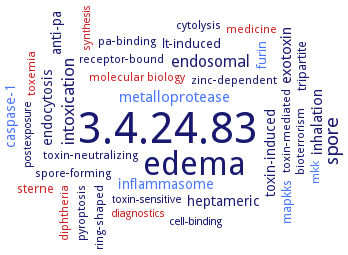3.4.24.83: anthrax lethal factor endopeptidase
This is an abbreviated version!
For detailed information about anthrax lethal factor endopeptidase, go to the full flat file.

Word Map on EC 3.4.24.83 
-
3.4.24.83
-
edema
-
spore
-
intoxication
-
endosomal
-
exotoxin
-
metalloprotease
-
inhalation
-
inflammasome
-
endocytosis
-
toxin-induced
-
anti-pa
-
heptameric
-
caspase-1
-
sterne
-
furin
-
mapkks
-
lt-induced
-
tripartite
-
diphtheria
-
toxin-mediated
-
spore-forming
-
pyroptosis
-
toxemia
-
ring-shaped
-
receptor-bound
-
toxin-neutralizing
-
zinc-dependent
-
molecular biology
-
cytolysis
-
pa-binding
-
medicine
-
mkk
-
bioterrorism
-
diagnostics
-
toxin-sensitive
-
synthesis
-
postexposure
-
cell-binding
- 3.4.24.83
-
edema
- spore
-
intoxication
- endosomal
-
exotoxin
- metalloprotease
-
inhalation
- inflammasome
-
endocytosis
-
toxin-induced
-
anti-pa
-
heptameric
- caspase-1
- sterne
- furin
- mapkks
-
lt-induced
-
tripartite
- diphtheria
-
toxin-mediated
-
spore-forming
-
pyroptosis
- toxemia
-
ring-shaped
-
receptor-bound
-
toxin-neutralizing
-
zinc-dependent
- molecular biology
-
cytolysis
-
pa-binding
- medicine
- mkk
-
bioterrorism
- diagnostics
-
toxin-sensitive
- synthesis
-
postexposure
-
cell-binding
Reaction
Preferred amino acids around the cleavage site can be denoted BBBBxHx-/-H, in which B denotes Arg or Lys, H denotes a hydrophobic amino acid, and x is any amino acid. The only known protein substrates are mitogen-activated protein (MAP) kinase kinases =
Synonyms
anthrax lethal factor, anthrax lethal factor protease, anthrax lethal toxin, anthrax LF, anthrax toxin lethal factor, Bacillus anthracis lethal toxin, lethal factor, lethal factor of anthrax toxin, lethal toxin, LeTx, LF, LTx
ECTree
Advanced search results
Crystallization
Crystallization on EC 3.4.24.83 - anthrax lethal factor endopeptidase
Please wait a moment until all data is loaded. This message will disappear when all data is loaded.
docking and molecular dynamics calculations to examine the anthrax lethal factor-MEK/MKK interaction along the catalytic channel up to a distance of 20 A from the zinc atom. The Zn-bound water molecule is predicted to form hydrogen bonds with the carbonyl oxygen of Ile, i.e. P1' of substrates MEK1, MKK3b, Leu, ie. P1' of substrate MKK4-1, and Leu, ie. P2 of substrate MKK6b as well as with the hydroxyl group of Thr, i.e. P2' of substrate MKK4-2. This hydrogen bond is an additional contact to the already existing polarization of the carbonyl oxygen between Zn and Glu687 carboxylate
-
in complex with inhibitor 3-(N-hydroxycarboxamido)-2-isobutylpropanoyl-Trp-methylamide, structure is used for pharmacopore model
in complex with inhibitors N-2-benzyl-N-2-[(4-fluoro-3-methylphenyl)sulfonyl]-N-hydroxy-D-alaninamide, N2-[(4-fluoro-3-methylphenyl)sulfonyl]-N-hydroxy-N-2-(4-nitrobenzyl)-D-alaninamide, N-2-[4-(aminomethyl)benzyl]-N-2-[(4-fluoro-3-methylphenyl)sulfonyl]-N-hydroxy-D-alaninamide to 2.2-2.5 A resolution. Identification of frequently populated conformational states termed bioactive, open and tight. The bioactive position is observed with large substrate peptides and leaves all peptide-recognition subsites open and accessible. The tight state is seen in unliganded and small-molecule complex structures. In this state, domain 3 is clamped over certain substrate subsites, blocking access. The open position appears to be an intermediate state between these extremes and is observed owing to steric constraints imposed by specific bound ligands
structural analyzation by NMR-spectroscopy leading to 96% assignment of the backbone amides and overall assignment of 1HN, 15N, 13Calpha, 13Cbeta and 13C' chemical shifts to 85%


 results (
results ( results (
results ( top
top





